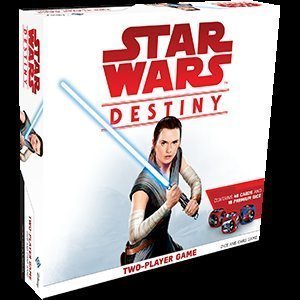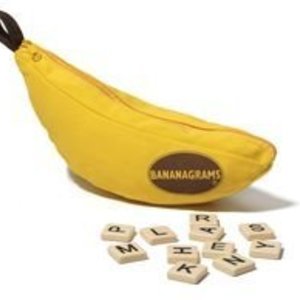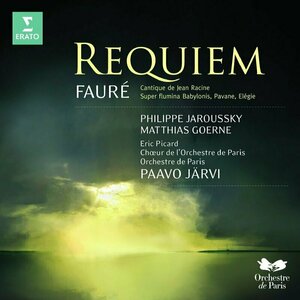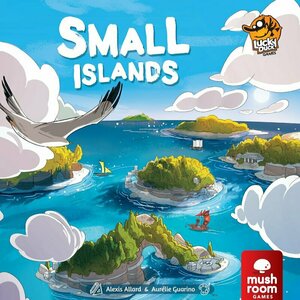
Dusty: An Intimate Portrait of a Musical Legend
Book
Known the world over for her unique musical style, distinctive look and a voice that propelled her...
Andy Gill recommended Requiem by Gabriel Faure in Music (curated)
Brian Fallon recommended Hammersmith Odeon, London '75 by Bruce Springsteen in Music (curated)

Star Wars: Destiny
Tabletop Game
Captain Phasma and Greedo battle Han Solo and Luke Skywalker in the Jedi Temple on Coruscant. Boba...

Bananagrams
Tabletop Game
Bananagrams is a fast and fun word game that requires no pencil, paper or board, and the tiles come...

Daily Solitaire
Games and Stickers
App
Daily Solitaire: Poker Saga is a fantastic example of how to make a mobile solo card game that's...

A Pocket of Wind Resistance by Karine Polwart
Album Watch
The first studio album from the acclaimed Karine Polwart in over 5 years. A Pocket Of Wind...
pop folk

MultiBox Lite - HobbyBox Sattelite
Entertainment and Lifestyle
App
Enjoy the experience of watching live TV on your iPad, iPhone and iPod from your set-top box. Enjoy...
Purple Phoenix Games (2266 KP) rated Macaron in Tabletop Games
Oct 20, 2020
Macaron is a baked goods-themed trick-taking card game for one to five players. In it players are bakers in medieval France trying to become the favored royal baker to the king and his family. The player who can earn the most VP by delivering the tastiest macarons to the royal family will be victorious and will then bake the other players a box of macarons to take home (I added that last part, but Ta-Te Wu should consider adding it to the rules).
DISCLAIMER: We were provided a prototype copy of this game for the purposes of this review. These are preview copy components, and I know for sure the final components will be slightly different from these shown. Also, it is not my intention to detail every rule in the game, as there are just too many. You are invited to download the rulebook, back the game through the Kickstarter campaign, or through any retailers stocking it after fulfillment. -T
For this preview I am tackling the solo rule-set provided and my AI opponent is named Emma (per the rules). Multiplayer games will be played somewhat similarly, but against normal-intelligenced real people. Duh.
To setup a solo game, place the Score board in the middle of the table on whichever side is decided – one side allows up to 20 points, and the other up to 30. Place the first three Group boards (A with Almond and Pistachio, B with Strawberry and Blueberry, and C with just one Green Tea macaron upon it) somewhere near the Score board to denote the flavors being played. Remove all cards from the deck picturing Earl Grey and Chocolate flavored macarons. Shuffle the remaining macaron cards and deal the solo player 13 of them. Deal Emma one random card from the deck under each flavor on the Group board as shown below. These random cards will take on the flavor of whichever stack to which it now belongs. Continue dealing Emma eight cards to her stacks, but match them to their flavors – the 4 of Pistachio under Pistachio, etc. Emma should now have 13 cards in total, but each flavor stack should be shuffled and arranged as shown below. Choose a color for the player and for Emma, place one of each meeple on the Score board to track final scores, and the other meeples on the Gift Box tracker in the middle. Analyze each of Emma’s stacks to determine which Group contains the most cards. These flavors will be given the Royal token (I used the purple star) and are considered the trump suits this round. Flip over the top card of the deck that remains, and place the Allergen token (I used the tall goldenrod piece) upon the matching flavor. The game may now begin!
The solo player is always the starting player, so they will open the first trick by playing a card from hand. As in most card games, whichever flavor (suit) is led will need to be followed by Emma, if possible. The rulebook gives the player a nice turn-flow summary for Emma based on which player leads and which type of card is played.
As in Euchre, suit must be followed. If a player is unable to follow, they may play a Royal (trump) card to win the trick or any other non-Royal card. The Royal flavors are both flavors that belong to the same Group, or Green Tea, as it is its own Group. For each trick won, the player will advance their meeple on the Gift Box track to denote number of tricks won. Some card rules adjust the scoring. For example, should a value 1 card win the trick the winning player will increase their number of Gift Boxes three spaces instead of one. Should a trick include an Allergen flavor the winning player will still lead the next trick but will not advance their Gift Box meeple, as Allergens make the royal family sick. However, should a trick contain a value 2 card in it, the 2 cancels the Allergen and the winner may advance their Gift Box meeple as normal.
The round ends when a player, or Emma, has finished their hand of 13 cards played or reaches eight or more Gift Boxes (won tricks). Setup for a new round as the game was initially setup with dealing cards to each player and determining Royal and Allergen flavors. Play continues in this fashion until the player or Emma has reached the pre-determined score of 10, 20, or 30. The winner must now get to baking (again, I added that, but it REALLLLLY needs to happen, I think)!
Components. Again, this is a prototype copy of the game (though still pretty good) and the final components will certainly be different than the ones shown here. That said, the art style is simply wonderful and incredibly enjoyable. Yes, the Score board is a little busy, but it’s functional and fun. The art on the cards is very good, colorblind-friendly with icons in addition to colors, and the art doesn’t get in the way of playing tricks at all. All the other components used in the game will probably be different upon a successful Kickstarter campaign, and though I haven’t seen the proposed components, I am sure they will match the theme and be great to handle.
So as a lover of Euchre, am I also a lover of Macaron? ABSOLUTELY! It takes everything I enjoy about Euchre and somehow simplifies AND complexifies it. Teaching Euchre to new players can be a chore when they don’t latch onto the fact that the highest cards in the game are the Jacks of the same color of trump, but one is higher than the other. It can be awkward at first. Here, there are one or two flavors that are trump suits. It makes sense to be able to visualize a bit easier, and to be able to relate to flavors. In fact, my 4-year-old son wanted to “play” it earlier this morning, so I took out the Allergen mechanic and just did straight suit-following with trumps and he understood it. So, I guess by house-ruling a little you can also play this with children who are learning games for the first time, learning their numbers, or learning trick-taking games. That’s a fun hidden side quest!
Now, I can see how people will totally dig Macaron as a multiplayer game, but I am previewing this as a solo game. Is it just as good? Yep! I like being able to play the game whenever I want, and using another mechanic I didn’t describe earlier – Betting. Having to bet upon how many Gift Boxes you will score for the round adds another layer of analyzation I particularly enjoy. If you guess correctly you score an additional two Gift Boxes. If you’re wrong Emma scores two Boxes. Couple this with Emma’s unpredictable card play and you have an interesting AI player that you may never be able to “figure out” and beat methodically. I like that randomness from Emma. She has made a few games close, but ultimately has lost every game against me.
Macaron is a cute little Euchre-style card game that can be played well solo and multiplayer, and features wonderful style. I love the theme, and I seem to be attracted to food games; I love Bohnanza, Morels, Happy Salmon (my favorite fish to eat), Sushi Go!, Coconuts, and The Three Little Pigs (ok that one was mean, but hey, I love pork)! If you also enjoy food-related games, or trick-taking games, or just fun little card games you can play solo or with other people, please consider backing Macaron via their Kickstarter campaign launching soon. Tell them Purple Phoenix Games sent you and I will share my Gift Box of Macarons with you**. You will have to let me know your food allergies prior, though.
** I don’t actually have a Gift Box of Macarons. That was a lie, and I apologize for that.
Purple Phoenix Games (2266 KP) rated Small Islands in Tabletop Games
Oct 13, 2021
Small Islands is a tile placement exploration game for one to four players. In it, players are explorers tasked with discovering resource-rich new islands upon which their clans may either exploit or inhabit. However, it’s each clan for themselves, and the players all need those precious resources. In the solo game, the player’s AI opponent is Alexis Allard, designer of the game. He has goal cards to be used and finishing point totals that the solo player will be attempting to beat during the course of the game.
DISCLAIMER: We were provided a copy of this game for the purposes of this review. This is a retail copy of the game, so what you see in these photos is exactly what would be received in your box. I do not intend to cover every single rule included in the rulebook, but will describe the overall game flow and major rule set so that our readers may get a sense of how the game plays. For more in depth rules, you may purchase a copy online or from your FLGS. -T
To setup, the player claims their player color and assigns Alexis with his color. They take all the components for each player and places them on the table. The starting tiles (that feature flying seagulls) are placed on the table in any orientation that is legal for play: islands need to connect, and seas need to flow from one tile to the next, as seen below. The Landscape tiles are to be shuffled and placed within reach. The four ship tiles are displayed, with all ships on their gray side, save for the solo player’s chosen color. The Navigation tile is placed below the ship tiles, and the beginning three Landscape tiles are placed in a row beside it. The small stack of Objective cards are shuffled and placed nearby, with the player drawing one to begin. They also draw two Landscape to start. For solo play, one Alexis difficulty card is chosen, and his deck of Explore and Land cards is built accordingly. The Prestige (VP) tokens are (apparently when I play) just thrown on the table and gathered in a loose pile. The game may now begin!
Small Islands is played over four rounds, with several turns being played per round. The solo player begins each round with their turn. A turn is divided into three phases: Preparation, Exploration, Reward. The Preparation phase has the player populating the Navigation Tile with six Landscape tiles face-down as a draw stack. The player then draws two Objective cards to add to their one they are currently holding. From these three cards the player will choose one to become their current objective for the round, one to be saved for a future round, and one to be discarded back to the stack. These Objective cards provide a strategy to guide the player through the current round, and also setup future rounds for scoring purposes. Upon them are icons that will award the player with points for scoring islands containing specific combinations of resources.
During the Exploration phase in the solo game, the player takes their turn first, and then Alexis will take his. A typical Exploration phase has a player deciding if they will Explore a tile or Land a ship. To Explore a tile, the player chooses one of the face-up Landscape tiles from the market/offer row and, along with their two held tiles, choose one to add to the play area. These tiles may be rotated in any fashion, as long as they can be legally placed: island edges are to be extended, sea spaces connected, et al. It is also at this time the player may place one of their Bonus Tokens upon any tile on the play area. These Bonus Tokens are resource icons that cover up existing icons on a tile, or directly over another Bonus Token. A player would do this in order to affect the balance of icons on a given island for scoring purposes.
Should the Navigation tile be empty of Landscape tiles and the player wish, they may instead Land a ship, thus ending the Exploration phase. The player chooses any of the ship tiles, and places it legally on the play area (in a sea space, as shown below). Once the player ends the phase, the game progresses to the Reward phase.
After the player takes their turn during the Exploration phase, Alexis takes his turn. This is done by drawing an Expedition card from his stack and following its instructions. The Expedition card will show whether Alexis would like to Explore or Land, which Landscape tile he would like to draw, and where he would like to place it – in relation to where the last player tile was placed.
During the Reward phase, the player will place any of their clan houseeples they wish on any island upon which they have not placed a houseeple previously. Then, consulting their Objective card, score points for successfully satisfying the card’s requirements. For Alexis, the player will draw a new Expedition card from Alexis’s stack, note the icons present on the Mission area of the card, and place Alexis houseeples upon islands that satisfy its requirements.
The game continues in this fashion until the fourth round is complete. The player totals their Prestige points (VP) and if they score more than Alexis, they win! The player must then take a picture of their archipelago they built and send it to the designer directly and gloat to them about their massive victory. Or simply rest in the satisfaction of having played the game well. Whichever.
Components. This game has a lot of components, and they are mostly cardboard and houseeples. The cardstock and board are good quality, as I have come to expect from Lucky Duck Games, and the houseeples are all different shapes for each clan color. I find that a nice and unnecessary, but very cool, touch. The art in this one is simply amazing. I mean, look at these photos! Everything from the color scheme to the art style all mesh well and give a well-considered polish to a great theme.
Okay, I won’t even hide it – I LOOOOOOVE this game. I never really liked Carcassonne very much, but Small Islands gives a similar feel, but executes everything so much better. Even with the solo rules. There are so many options available at any one time, and having a random Alexis game each time you play is just so satisfying. I feel like I could keep this game forever and not play the same game twice. Ever. And I think that I would WANT to play this one forever. Yes, I think this is a solid fit for my collection indeed, and I can see it working for so many different gamer types.
Having Alexis constantly applying the pressure to maximize and strategize every turn is delicious, and having almost zero conflict with him as we both explore is welcome. You know when you start the game how many points Alexis will score at the end of the game, so having that knowledge really makes you consider all the options available. It just works on so many levels.
If you are looking for a light-hearted, but with some great decisions to be made, then I strongly urge you to check out Small Islands. I knew immediately that this was a game for me. It’s on the lighter side without being too simple, I get to build a thing and admire it at the end of the game, and I have an opponent who just wants to see me win because he designed the game! I’m in and out in less than an hour and feel content that I was able to have a great experience with a well-designed game. I cannot wait to introduce this to all my friends and family gamers so they can fall in love with it as well.



